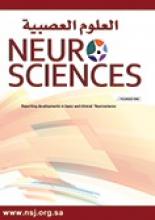Article Figures & Data
Tables
Variables Frequency (%) Gender Male 36 (59.0) Female 25 (41.0) TSC type TSC 1 9 (14.8) TSC 2 23 (37.7) Untested genetically 29 (47.5) Epilepsy Intractable epilepsy 28 (45.9) Monotherapy 25 (40.9) No epilepsy 8 (13.1) Tuberous sclerosis associated neuropsychiatric disorders (TAND) Yes 45 (73.8) No 16 (26.2) Age Mean (±SD) Current age of participants 11.3±6.7 Age at diagnosis 4.9±4.9 SD - Standard deviation; TAND - Tuberous sclerosis associated neuropsychiatric disorders; TSC - Tuberous sclerosis complex
Criterias n (%) Major criteria Subependymal nodules (≥2) 53 (86.9) Hypomelanotic Macules ((≥3; at least 5 mm diameter) 39 (63.9) Multiple cortical tubers and//or radial migration lines 39 (63.9) Angiomyolipoma (≥2) 24 (39.3) Shagreen patch 16 (26.2) Angiofibroma (≥3) or fibrous cephalic plaques 15 (24.6) Cardiac rhabdomyoma 15 (24.6) Multiple retinal hamartomas 13 (21.3) Ungual fibromas (≥2) 1 (1.6) Minor Criteria Multiple renal cysts 17 (27.9) Confetti Skin Lesions 2 (3.3) Sclerotic bones lesions 1 (1.6) Intraoral fibromas 1 (1.6) Non-renal hamartomas 1 (1.6) Variables Mean±SD Non-renal hamartomas 1.0±0 Cardiac rhabdomyoma 1.6±2.8 Subependymal nodules 4.1±4.7 Multiple renal cysts 4.4±3.8 Confetti Skin Lesions 4.5±0.7 Multiple cortical tubers and//or radial migration lines 4.5±5.2 Hypomelanotic Macules 4.8±4.1 Intraoral fibromas 6.0±0 Subependymal Giant Cell Astrocytoma 6.7±6.3 Shagreen patch 6.8±4.4 Multiple retinal hamartomas 7.2±5.9 Angiomyolipoma 8.4±4.9 Angiofibroma or fibrous cephalic plaques 9.1±4.0 Dental Complications 9.8±4.8 Sclerotic bones lesions 11.0±0 Ungual fibromas 13.0±0 - Table 4
- The distribution of tuberous sclerosis complex (TSC) features stratified by gender.
TSC Features Male N (%) Female N (%) P-value Hypomelanotic Macules 28 (77.8) 11 (44) 0.007* Angiofibroma or fibrous cephalic plaques 10 (27.8) 5 (20) 0.488 Ungual fibromas 0 (0) 1 (4) 0.226 Shagreen patch 11 (30.6) 5 (20) 0.357 Multiple retinal hamartomas 8 (22.2) 5 (20) 0.835 Multiple cortical tubers and//or radial migration lines 22 (61.1) 17 (68) 0.582 Subependymal nodules 29 (80.6) 24 (96) 0.079 Subependymal Giant Cell Astrocytoma 7 (19.4) 7 (28) 0.435 Cardiac rhabdomyoma 10 (27.8) 5 (20) 0.488 Angiomyolipoma 15 (41.7) 9 (36) 0.656 Confetti Skin Lesion 2 (5.6) 0 (0) 0.231 Dental Complications 7 (19.4) 4 (16) 0.731 Intraoral fibromas 0 (0) 1 (4) 0.226 Multiple renal cysts 11 (30.6) 6 (24) 0.574 Non-renal hamartomas 1 (2.8) 0 (0) 0.401 Sclerotic bones lesions 1 (2.8) 0 (0) 0.401 - Table 5
- The presentation of tuberous sclerosis complex (TSC) features stratified by gender.
TSC Features Male Mean±SD Female Mean±SD P-value Hypomelanotic Macules 4.9±4.2 4.7±4.1 0.888 Angiofibroma or fibrous cephalic plaques 8.2±4.3 10.8±3 0.266 Shagreen patch 7±4.5 6.4±4.5 0.800 Multiple retinal hamartomas 6±5.3 9±6.9 0.391 Multiple cortical tubers and/or radial migration lines 2.7±3 6.7±6.6 0.017* Subependymal nodules 3.2±3.3 5.2±5.8 0.138 Subependymal Giant Cell Astrocytoma 6.2±4.9 7.2±7.9 0.798 Cardiac rhabdomyoma 2±3.4 0.8±1.1 0.469 Angiomyolipoma 8.2±4.4 8.8±5.8 0.758 Dental Complications 10±4.7 9.2±5.7 0.785 Multiple renal cysts 4.4±3.1 4.5±5.1 0.985 Seizure 4±3.9 3.3±4.4 0.510 - Table 6
- The distribution of seizure types, TAND manifestations, and electroencephalography findings and epilepsy and TSC complications management profile across the study sample.
Variables n (%) Seizure Type Generalized motor tonic-clonic seizure 23 (37.7) Mixed seizure 22 (36.1) Epileptic spasms 20 (32.8) Focal motor 19 (31.1) Unclassified seizure type 14 (23.0) Absence seizure 9 (14.8) Lennox Gastaut 3 (4.9) Juvenile myoclonic epilepsy 1 (1.6) Other 7 (11.5) TAND manifestations Learning disability 32 (52.5) Speech delay 28 (45.9) Intellectual disability 27 (44.3) Global developmental delay 26 (42.6) Social/ cognitive delay 25 (41.0) Fine motor delay 11 (18.0) ASD 11 (18.0) Gross motor delay 10 (16.4) ADHD 9 (14.8) Electroencephalography findings Focal abnormality 19 (31.1) Focal frontal epileptiform discharges 12 (19.7) Focal temporal epileptiform discharges 12 (19.7) Focal parietal epileptiform discharges 3 (4.9) Focal occipital epileptiform discharges 8 (13.1) Generalized slow abnormality 8 (13.1) Other EEG finding 7 (11.3) Generalizes spike/wave epileptiform discharges 6 (9.8) 3 Hz Spike wave discharges 1 (1.6) Epilepsy management profile Anti-seizure medication 45 (73.8) Single anti-seizure medication 18 (29.5) Two or more anti-seizure medication 27 (44.3) Surgery for Seizure 4 (6.5) SEGA surgery 3 (4.9) mTOR inhibitors 3 (4.9) Vagus nerve stimulation 1 (1.6) Management of TSC complications Surgery for Seizure 4 (6.5) Cardiac rhabdomyoma surgery 1 (1.6) Multiple retinal astrocytoma surgery 1 (1.6) Renal transplant 1 (1.6) V-P shunt insertion 1 (1.6)






